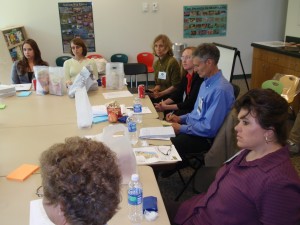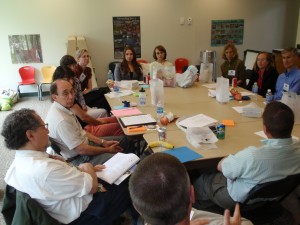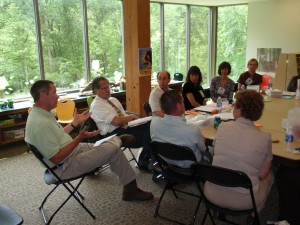Tough issues ahead for Maryland program
 COLUMBIA, MD – About 140 persons attended the Maryland Land Conservation Conference in May and heard the expertise of numerous presenters and exchanged ideas in roundtable meetings. The annual conference is sponsored by the Maryland Environmental Trust, the state’s quasi-governmental land trust and was held in Howard County at the recently opened LEED-certified Robinson Nature Center. The conference attracted both government conservation employees and land trusts. About nine county-level farmland preservation program administrators from Maryland attended.
COLUMBIA, MD – About 140 persons attended the Maryland Land Conservation Conference in May and heard the expertise of numerous presenters and exchanged ideas in roundtable meetings. The annual conference is sponsored by the Maryland Environmental Trust, the state’s quasi-governmental land trust and was held in Howard County at the recently opened LEED-certified Robinson Nature Center. The conference attracted both government conservation employees and land trusts. About nine county-level farmland preservation program administrators from Maryland attended.
Kevin Case, Northeast Director for the Land Trust Alliance reported 160 land trusts operating within the Chesapeake Bay watershed. He said that the LTA has been focusing on improving the quality of land conservation, accelerating the pace of easement and land purchases and donations, and ensure the permanence of all conservation transactions.
Agricultural land preservation program administrators met in two roundtables. The first included non-administrators and the second was for Maryland county-level program managers with some staff of the Maryland Agricultural Land Preservation Foundation (MALPF). The Foundation, governed by an appointed board, operates the state’s purchase of development rights program, which has had much of its funding diverted to the state’s general fund over the last five years as state leaders look to prop up Maryland’s ailing economy.
Baltimore County program administrator Wally Lippincott and American Farmland Trust Mid-Atlantic Director Jim Baird facilitated both sessions.
 County administrators went over a number of difficulties that continue to trouble the MALPF program at the county and state levels. Enforcing subdivision regulations and other “stewardship issues” identified by MALPF staff member Diane Chasse, are overwhelming staff, she said.
County administrators went over a number of difficulties that continue to trouble the MALPF program at the county and state levels. Enforcing subdivision regulations and other “stewardship issues” identified by MALPF staff member Diane Chasse, are overwhelming staff, she said.
Many county-level programs have no money for easement purchases this year. The MALPF program received $8.7 million for FY13, approved by the legislature in April, not enough to purchase even one easement per county. The MALPF board voted to wait until the next appropriation and combine funds, a repeat strategy that has counties looking to their own resources to keep programs active. But the state’s only county-level programs that are funded in amounts adequate to the task are those operated by Harford and Carroll Counties. Both Harford and Carroll counties use installment purchase agreements (IPAs) to stretch dollars. Harford’s and Carroll’s IPAs pay 20 years of tax-free interest on the amount offered to the landowner, with the full offer, bound in a zero coupon bond, maturing and paid out at the end of the period. Harford pays interest based on the market rate, but Carroll will pay 5.25 percent interest in its current round in exchange for accepting offers of just 40 percent of appraised fair market value. Carroll paid 6 percent in for offers approved in 2011.
Harford program administrator Bill Amoss reported his program with $4 million after a four-year hiatus due to low revenues from a local real estate transfer tax. The transfer tax revenue that is dedicated to the program must be guarded to pay the interest on existing agreements, and if revenue falls short, no new easements will be purchased. With new applications from 30 farms, only nine farms totaling about 1,300 acres will receive offers this year. Amoss reported that offers are approximately half of the amounts they were in the last round in 2008. Rather than using appraisals, Harford makes offers derived from a points-based appraisal system.
Deborah Bowers, preservation specialist for Carroll County, reported the Carroll program with a notable $11 million that will be spent on both installment purchases and lump sum payouts to qualifying applicants who request it. Carroll’s purchase fund is the largest in the state and supports a preserved acre tally of 62,000 acres. Carroll has more than 30 applications in hand, with about half requesting full payment at settlement. Ranking is underway using a recently revised LESA point scoring system. Like Harford, the Carroll program also uses a 20-year agreement that pays tax-free interest twice annually, but through the county general fund, an aspect that has been troubling to the Board of County Commissioners who nevertheless did not cut the program budget. A zero coupon bond is purchased for each agreement in the amount of the purchase offer and becomes mature at 20 years, at which time the landowner receives the full amount of the offer. What sets the Carroll program apart from Harford and all other IPA programs in use, all in the Mid-Atlantic, is that offers are capped at 40 percent of appraised value; in exchange, the county agrees to pay the notable 5.25 percent interest that results in an ultimate payout to the landowner at the end of the period of above 80 percent. Four recent appraisals in Carroll show values for land only, ranging from $5699 to $8250 per acre.
Easement valuation in the MALPF program continues to be debated and a committee has been meeting to determine recommendations. In Maryland, easement value is determined by subtracting a formula-based agricultural value from the appraised fair market value. The agricultural value is determined by a statutory formula that calculates a land rent based on soil productivity, or, the five-year average cash rent paid in the subject county, whichever is lower. The formula has come under fire from a number of program administrators who feel it has resulted in per-acre easement values that are too high. In about eight counties MALPF easement offers reflected 80 percent or more of appraised fair market value in recent years. Both Harford and Carroll counties have capped offers at 70 percent of fair market value. Bill Amoss told fellow administrators at the conference rountable that he favored the MALPF program using a before-and-after appraisals, or the point system approach used by many land trusts and counties in the Rural Legacy Program, operated by the Dept. of Natural Resources. A report by the valuation committee will be given to the MALPF board in June.
County administrators discussed, following the conference, changing the policy that requires that three of five members of county advisory boards be owner-operators of commercial farms who earn 50 percent or more of their income from farming. Administrators voted by email in June to approve a proposal by their legislative committee to add to this policy that localities can add to or replace the income measure with other membership requirements as long as they reflect agricultural knowledge and experience of the applicant.
Administrators briefly discussed enactment of SB 236 and PlanMaryland. SB 236, titled the Sustainable Growth and Agricultural Preservation Act of 2012, is widely known as the “septic bill.” The new law was the culmination of more than two years of examining how to limit growth in the state’s rural areas as the key to slowing the pollution of the Chesapeake Bay. After failed attempts in the past to enact state zoning to limit density, the linchpin of SB236 was curbing growth by limiting the number of new septic systems statewide. Due to a number of complicated provisions in the bill that are confounding county as well as state planners, the jury is still out as to whether the overall effect will be fewer new homes in rural areas. The new law compels counties to overlay their zoning maps with four possible residential growth levels called tiers. Each tier carries certain allowances for density based on whether a development proposal is deemed to be minor (up to seven) or major (more than seven and up to 15).
